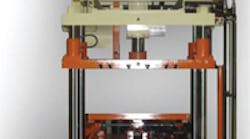A machine-tool builder has introduced an energy-saving trim press design that features hybrid-servoactuator (HSA) technology, which allows users to reduce energy usage without sacrificing any of the finishing capability of hydraulic trim press designs. While this improves the producers’ cost for finishing castings, the new design also reduces plant noise levels, lessens fluid cleanup, and cuts down the amount of hosing needed to serve the unit.
Metal Mechanics Inc. demonstrated its HSA trim press design at CastExpo 2008 in May, to great interest among foundrymen and diecasters. The Michigan company (www.metalmechanics.com) has supplied trim presses to more than 250 diecasters since 1971, a market niche it still serves. But company president Tom Dailey adds that there is growing interest in trim presses from permanent-mold and other metalcasting operations, including foundries producing ferrous castings: all these potential customers want to eliminate manual trimming and finishing of castings, he explains.
The HSA technology that is the core of the “Trim-Pressive” machine relies on servo- electric actuators to perform the majority of the unit’s vertical stroke motion while carrying up to 10 tons of platen and tool load.
The regenerative system is a closed hydraulic arrangement. An accumulator enables the discharge of the necessary highpressure oil to generate the force required to shear the metal at the very end of the stroke. This allows a 75-ton Trim-Pressive machine to use only 15 amps when operational and 1 amp when idle, as compared to 50 amps and 26 amps required by a hydraulic press of the same size.
Additionally, the sound level during operation drops from 72 dbA down to 66 dbA, and the amount of hydraulic fluid required is reduced from 80–100 gallons to only 15 gallons of bio-friendly oil.
“I believe that manufacturers have a responsibility to be environmentally- conscious,” says Dailey. “By thinking out of the box and looking at long-term investments, we can deliver ‘ecologically smart’ machines and processes without sacrificing quality, speed, or end-user profitability.”
The new Trim-Pressive machine is most energy effective at press sizes starting at about 50 tons with a gross machine weight limit of 40,000 lb.
A key feature is that HSA technology can be retro-fitted to existing hydraulic presses, saving customers the high cost of steel and additional labor, in addition to avoiding scrap from old machines. Plus, the design allows the entire HSA unit to attach to a press frame with just 16 bolts. “On a rebuild, customers can reduce their carbon footprint and gain the advantages of the HSA technology for less than they would pay for a new hydraulic press,” Dailey explains. “Reducing energy consumption might be an easier way to increase profits than chasing new sales.”
Press sizes and capacities are determined by the metal and casting process a customer uses. Dailey says Metal Mechanics prefers to “build a press for the customer’s process needs rather than offer standard size presses.”
At CastExpo, the company also introduced new automated trim presses that integrate a robot load station, trim station, part unload mechanism, and scrap dump station into one modular unit. In this design, as the press comes down to cut the metal in the trim station, a previously trimmed part is unloaded, a new casting is loaded, and the scrap is dumped — each and every cycle — helping to maximize production potential.
The unit is based upon a shuttle that rolls under the press as the robot loads the metal casting. Then the part is trimmed and the shuttle moves away from the press to dump the scrap into a conveying unit. Because the design relies on a lean modular concept, the automated rollover unit can be adjusted for different sizes of scrap and integrated into any size Metal Mechanics trim press. Housekeeping issues are reduced, too, as are costs related to manual scrap handling and removal, because the unit quickly evacuates scrap and flash away from the casting trimming process.
“Removing scrap material from any metal cutting or forming process can slow down production,” says Dailey. “Yet, machine builders tend to focus machine design on the process that affects the finished product, not on one that looks at the removal of scrap. We want to conserve motion and energy as much as possible by this design.”










